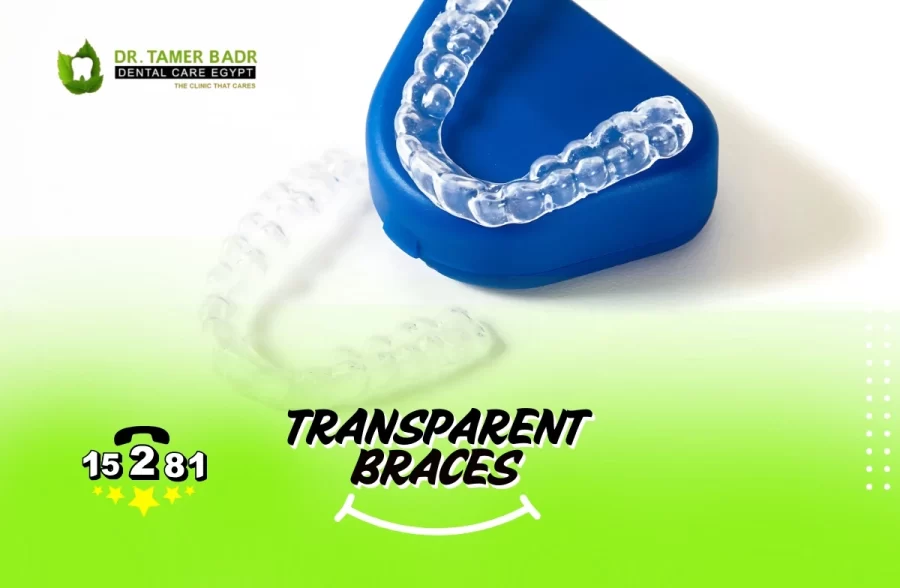
Transparent braces have revolutionized orthodontic treatment by offering a discreet and effective solution for teeth alignment. This article provides a comprehensive overview of transparent braces, including their various types—such as clear aligners and ceramic braces—the benefits they offer, and the scenarios in which they are most suitable.
Whether you’re considering orthodontic treatment for aesthetic reasons or to address specific dental issues, understanding the options available can help you make an informed decision
What Are Transparent Braces?
Transparent braces, also known as clear braces, are orthodontic devices designed to straighten teeth while offering a more discreet appearance compared to traditional metal braces. They are particularly popular among individuals who seek effective dental alignment solutions without the conspicuous look of metal brackets and wires.
Types of Transparent Braces
Ceramic Braces: These function similarly to traditional metal braces but use tooth-colored or clear ceramic brackets, making them less noticeable. Sometimes, tooth-colored wires are also used to enhance aesthetics.
Clear Aligners: Removable trays made from transparent plastic that fit snugly over the teeth. They are custom-made and replaced every few weeks to gradually shift teeth into the desired position.
Lingual Braces: These are similar to traditional braces but are attached to the backside (lingual side) of the teeth, making them invisible from the front.
Advantages of Transparent Braces
Aesthetic Appeal: Their discreet nature makes them a preferred choice for adults and teens concerned about the appearance of metal braces.
Effective Treatment: Transparent braces can effectively treat various dental issues, including overcrowding, gaps, overbites, and underbites.
Comfort: Clear aligners, in particular, offer increased comfort as they are smooth and removable, reducing the risk of mouth sores.
Considerations
Maintenance: Ceramic brackets can stain if not properly cared for, and clear aligners require diligent cleaning.
Cost: Transparent braces may be more expensive than traditional metal braces, depending on the type and treatment duration.
Suitability: Not all orthodontic issues can be addressed with transparent braces. A consultation with an orthodontist is essential to determine the most appropriate treatment.
In summary, transparent braces offer an effective and aesthetically pleasing alternative to traditional braces. They combine functionality with discretion, making them an excellent choice for many seeking orthodontic treatment.
How Do Transparent Braces Work?
Transparent braces, encompassing both clear aligners and ceramic braces, offer discreet orthodontic solutions by applying controlled forces to guide teeth into their desired positions.
How Clear Aligners Work
Clear aligners are custom-made, removable trays crafted from medical-grade, BPA-free plastic. Each aligner is designed to apply gentle, precise pressure to specific teeth, gradually shifting them over time. The treatment process involves:
Initial Assessment: A digital scan or impression of your teeth is taken to create a 3D model.
Customized Treatment Plan: Using specialized software, a series of aligners are designed, each slightly different to move teeth incrementally.
Sequential Wear: Patients wear each set of aligners for about 1–2 weeks, for 20–22 hours daily, before progressing to the next set.
Bone Remodeling: The applied pressure stimulates bone remodeling, allowing teeth to move into new positions.
This method is effective for treating mild to moderate dental misalignments, offering the advantage of being nearly invisible and removable for eating and cleaning.
How Ceramic Braces Work
Ceramic braces function similarly to traditional metal braces but use tooth-colored or clear brackets, making them less noticeable. The components include:
Brackets: Bonded to the front of each tooth, these brackets are made from durable ceramic materials that blend with natural tooth color.
Archwire: A metal wire connects the brackets and applies continuous pressure to move teeth into alignment.
Ligatures: Small elastic bands hold the archwire in place within the brackets.
Periodic Adjustments: Regular orthodontic visits are necessary to adjust the tension in the archwire, guiding teeth progressively into the desired position.
Ceramic braces are suitable for a wide range of orthodontic issues, including more complex cases that may not be addressable with clear aligners.
Benefits of Choosing Transparent Braces
Transparent braces, including clear aligners and ceramic braces, offer numerous advantages for individuals seeking a discreet and effective orthodontic treatment. Here are some key benefits:
1- Aesthetic Appeal:
One of the primary advantages of transparent braces is their subtle appearance. Clear aligners are virtually invisible, and ceramic braces use tooth-colored or clear brackets, making them less noticeable than traditional metal braces. This discretion is particularly appealing to adults and teens who are conscious about their appearance during treatment.
2- Enhanced Comfort
Transparent braces are designed with comfort in mind. Clear aligners are made from smooth plastic, reducing the likelihood of irritation to the cheeks and gums. Ceramic braces also tend to be gentler on the mouth compared to metal brackets.
3- Improved Oral Hygiene
Clear aligners are removable, allowing for easy cleaning of both the aligners and your teeth. This removability facilitates better oral hygiene practices, reducing the risk of plaque buildup and tooth decay during treatment.
4- Dietary Freedom
With clear aligners, you can remove them during meals, enabling you to enjoy a wide variety of foods without restrictions. This flexibility contrasts with traditional braces, which often require avoiding certain hard or sticky foods.
5- Fewer Orthodontic Visits
Transparent braces, especially clear aligners, often require fewer visits to the orthodontist for adjustments. This convenience can be beneficial for individuals with busy schedules.
In summary, transparent braces provide an effective and less conspicuous alternative to traditional braces, combining aesthetic appeal with practical benefits. Consulting with an orthodontist can help determine the most suitable option based on individual needs and preferences.
Types of Transparent Braces
Transparent braces offer discreet orthodontic solutions for individuals seeking to straighten their teeth without the conspicuous appearance of traditional metal braces. The primary types of transparent braces include clear aligners, ceramic braces, and lingual braces.
Clear Aligners
Clear aligners are custom-made, removable trays crafted from medical-grade, BPA-free plastic. They fit snugly over the teeth and are replaced every 1–2 weeks to gradually shift teeth into the desired position. Clear aligners are virtually invisible, allowing for a discreet treatment experience. They are also removable, facilitating easier eating and oral hygiene. However, their effectiveness is contingent upon consistent wear for 20–22 hours per day.
Ceramic Braces
Ceramic braces function similarly to traditional metal braces but use tooth-colored or clear ceramic brackets, making them less noticeable. They are fixed appliances that apply continuous pressure to move teeth into alignment. Ceramic braces are effective for a wide range of orthodontic issues, including more complex cases. However, they may be more susceptible to staining and can be more fragile than metal braces.
Lingual Braces
Lingual braces are attached to the backside (lingual side) of the teeth, rendering them invisible from the front. They function like traditional braces, using brackets and wires to move teeth into alignment. Lingual braces are highly discreet but may cause initial discomfort and can affect speech temporarily. They are also typically more expensive and may require longer adjustment periods.
Each type of transparent braces offers unique advantages and considerations. The choice among them depends on individual preferences, the complexity of the orthodontic issues, lifestyle, and budget. Consulting with an orthodontist can help determine the most suitable option for achieving optimal results.
Who Is a Candidate for Transparent Braces?
Transparent braces, encompassing clear aligners and ceramic braces, offer discreet orthodontic solutions for individuals seeking to straighten their teeth. However, their suitability depends on various factors, including the type and severity of dental issues, age, lifestyle, and commitment to treatment protocols.
1- Mild to Moderate Dental Misalignments
Clear aligners are effective for treating mild to moderate cases of misaligned teeth, such as:
- Crowded teeth
- Gapped teeth
- Overbites and underbites
- Crossbites
- Open bites
These aligners gradually move teeth into alignment using a series of custom-made, removable trays.
2- Moderate to Severe Misalignments
Ceramic braces are suitable for individuals with moderate to severe dental misalignments that may not be effectively addressed by clear aligners. They function similarly to traditional metal braces but use tooth-colored or clear brackets, making them less noticeable.
3- Adults and Teenagers
Transparent braces are popular among adults and teenagers who desire a less conspicuous orthodontic treatment. Their discreet appearance makes them an appealing choice for individuals concerned about aesthetics during treatment.
Who May Not Be Ideal Candidates?
1- Severe Orthodontic Issues
Individuals with complex dental problems, such as significant bite discrepancies or severe tooth rotations, may require traditional metal braces or other specialized treatments.
2- Young Children
Clear aligners are generally not recommended for children whose teeth and jaws are still developing, as the treatment requires a level of responsibility and consistency that may be challenging for younger patients.
3- Individuals with Poor Oral Hygiene
Maintaining excellent oral hygiene is crucial during orthodontic treatment. Patients who struggle with oral care may be at increased risk of cavities and gum disease, which can complicate treatment.
4- Smokers
Smoking can stain clear aligners and ceramic brackets, compromising their aesthetic advantage. Additionally, smoking increases the risk of gum disease, which can affect treatment outcomes.
Transparent braces offer an effective and aesthetically pleasing alternative to traditional metal braces for many individuals. However, suitability depends on specific dental conditions, age, lifestyle, and commitment to treatment protocols. Consulting with an orthodontist is essential to determine the most appropriate treatment option tailored to individual needs.
Treatment Process and Duration
The treatment process and duration for transparent braces—encompassing both clear aligners and ceramic braces—vary based on individual needs, case complexity, and adherence to the prescribed regimen. Here’s an overview of what to expect:
Clear Aligners: Process & Duration
Treatment Process:
Initial Consultation: An orthodontist evaluates your dental condition and determines if clear aligners are suitable for you.
Digital Impressions: Advanced 3D scanning technology captures detailed images of your teeth to design a customized treatment plan.
Aligner Fabrication: A series of custom-made, transparent trays are created to progressively shift your teeth into the desired position.
Regular Check-ups: Periodic visits to the orthodontist ensure the treatment is progressing as planned and allow for any necessary adjustments.
Treatment Duration:
The duration of clear aligner treatment varies depending on the complexity of the case:
- Mild Cases: Approximately 6 months.
- Moderate Cases: Around 8 to 10 months.
- Complex Cases: Up to 18 months or more.
On average, treatment lasts between 12 and 18 months
Ceramic Braces: Process & Duration
Treatment Process:
Initial Consultation: An orthodontist assesses your dental alignment and discusses treatment goals.
Bracket Placement: Tooth-colored or clear ceramic brackets are bonded to the front surface of each tooth.
Archwire Installation: A metal wire is threaded through the brackets, applying continuous pressure to move teeth into alignment.
Periodic Adjustments: Regular visits are scheduled to tighten the archwire and make necessary modifications
Treatment Duration:
Ceramic braces typically require a longer treatment period compared to clear aligners:
- Average Duration: Approximately 18 to 24 months.
- Complex Cases: May extend beyond 24 months, depending on the severity of misalignment.
The exact duration is influenced by individual factors and the specific orthodontic issues being addressed.
Factors Influencing Treatment Duration
Several factors can affect the length of orthodontic treatment with transparent braces:
- Severity of Misalignment: More complex dental issues require longer treatment times.
- Patient Compliance: Consistent wear of aligners and adherence to orthodontist instructions are crucial.
- Age: Younger patients often experience faster tooth movement due to higher bone remodeling rates.
- Oral Hygiene: Maintaining good oral health can prevent delays caused by complications like cavities or gum disease.
Consulting with an orthodontist will provide a personalized treatment plan and a more accurate estimate of the duration based on your specific needs.
Choosing transparent braces—whether clear aligners or ceramic braces—can be a transformative step toward achieving a confident, radiant smile. These discreet orthodontic solutions offer both aesthetic appeal and effective treatment for various dental alignment issues.
If you’re considering enhancing your smile with transparent braces, our team is here to assist you. Feel free to reach out to us through the contact numbers provided on our website or via WhatsApp. We’re ready to answer your questions and guide you toward the best orthodontic solution tailored to your needs.

